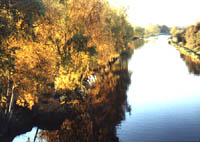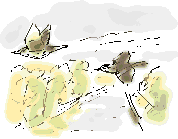
 As we stand on the canal bridge, looking at the curve of the canal framed by autumnal silver birches on one bank and the crimson-washed hawthorns on the other, a group of ten or twenty Redwings burst out of the hawthorns and a hawk appears behind them.
As we stand on the canal bridge, looking at the curve of the canal framed by autumnal silver birches on one bank and the crimson-washed hawthorns on the other, a group of ten or twenty Redwings burst out of the hawthorns and a hawk appears behind them. It looks scarsely bigger than the redwings and my first thought is of a Merlin. It is a plain grey-brown on it's back, much lighter brown, parchement almost, beneath, with a sprinkling of markings rather than full-blown barring on the breast.There is a band of darker brown at the end of it's tail. I can detect no sign of a moustachial stripe as it heads away at tree-top level, in a rather relaxed flight. It's wings aren't as pointed as those of a Kestrel normally appear. Possibly it is a rather small juvenile Sparrowhawk.
It looks scarsely bigger than the redwings and my first thought is of a Merlin. It is a plain grey-brown on it's back, much lighter brown, parchement almost, beneath, with a sprinkling of markings rather than full-blown barring on the breast.There is a band of darker brown at the end of it's tail. I can detect no sign of a moustachial stripe as it heads away at tree-top level, in a rather relaxed flight. It's wings aren't as pointed as those of a Kestrel normally appear. Possibly it is a rather small juvenile Sparrowhawk.
 By a farm, a large bushy Ivy is a mass of light green flowers. A wasp-mimic hoverfly feeds alongside a bee-mimic relative, probably a Drone-fly which resembles a honey bee. If so, it started life as a rat-tailed maggot, perhaps on the dung heaps of the farm, spending part of it's life cycle in stagnant water, where it's rat-tail serves as a snorkel.
By a farm, a large bushy Ivy is a mass of light green flowers. A wasp-mimic hoverfly feeds alongside a bee-mimic relative, probably a Drone-fly which resembles a honey bee. If so, it started life as a rat-tailed maggot, perhaps on the dung heaps of the farm, spending part of it's life cycle in stagnant water, where it's rat-tail serves as a snorkel.Richard Bell's Nature Diary, Thursday, 22nd October 1998
Next day
Previous day
Nature Diary
Wild West Yorkshire home page